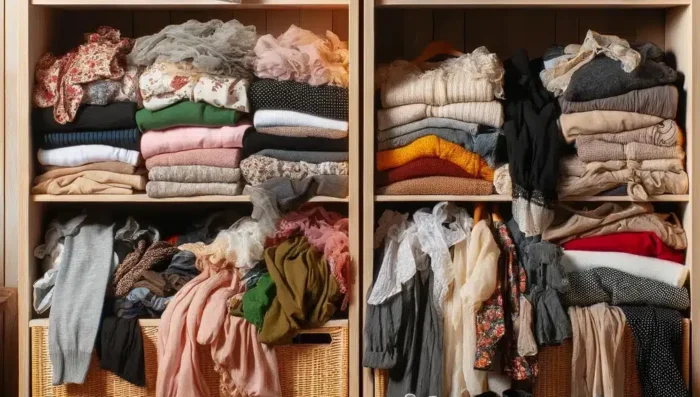Expert Space Solutions

With over 20 years in the home industry, we’ve helped many homeowners facing different challenges with organizing their closets. We get it! Keeping a tidy closet can be hard when balancing daily life with wanting an organized and inviting home.
It takes planning, creativity, and finally action to organize clothing efficiently. Over the years, we’ve identified most common organization issues that resonate with everyone at some point, regardless of the size of your home or the extent of your wardrobe.

1. Limited Space
Limited space can manifest as a feeling of opening your closet doors only to be met with a wall of clothing, shoes, and accessories packed so tightly that choosing an outfit can often lead to stress. This problem involves the closet functionality efficiency. The size of the closet is not an a factor, as any walk-in or reach-in can be optimized!
What It Looks Like:
Overstuffed Hanging Rods: Clothes are squeezed together so tightly that retrieving an item without disturbing its neighbors becomes impossible. This not only makes it difficult to see what you have but can also lead to wrinkles and damage to your clothes.
Piles of Clothing: Instead of being neatly stored away, clothes are often piled on shelves or the floor due to a lack of proper storage. These piles can quickly become disorganized, making it hard to find specific items and leading to clothes being forgotten or rarely worn.
Lack of Seasonal Storage: Limited closet space also means struggling to store out-of-season clothing effectively. Many find themselves resorting to under-bed storage, attics, or basements, which are not always ideal environments for garment preservation.
Action Plan:
Declutter & Prioritize: Begin by removing everything from your closet and categorizing your items into piles to keep, donate, or throw out. This not only simplifies decision-making but also ensures your closet contains only items that serve you well.
Maximize Vertical & Hidden Spaces: From floor-to-ceiling shelving units to double or triple hanging rods strategically placed to fit your wardrobe, our closets can store and access your belongings comfortably. For particularly high spaces, we have pull-down hanging rods, making it easy to reach items stored higher up.
Make Space for Accessories: Most homeowners underestimate how much of a mess these small items create. Belts, ties, scarves, and jewelry require storage to prevent tangling and damage. Our custom designs can include built-in organizers for these items, like velvet-lined jewelry drawers, tie racks, and scarf hangers.
2. Poor Visibility
Items stored too high, too deep, or in poorly lit areas of the closet are overlooked and forgotten, leading to a cycle of unused clothing and accessories.
Out of sight – out of mind rule works wonders, but not for the best! When clothes are too far back or shelves are too high, it’s hard to see all your choices. This can be frustrating. Much of your valuable wardrobe goes unused, diminishing the enjoyment and utility of your clothes.
What It Looks Like:
Frequently Wearing the Same Outfits: Finding yourself rotating through the same few outfits because they are the most accessible, despite having a full closet of options.
Rediscovering Items: The surprise of finding items you forgot you owned during a rare deep clean indicates they’ve been out of sight and reach for too long.
“I Have Nothing to Wear” Syndrome: Experiencing the paradox of feeling like you have nothing to wear despite standing in front of a full closet.
Action Plan:
Add Pull-Out Shelves: These allow you to easily access items stored further back in the closet, bringing them into full view with minimal effort.
Install Lighting: Consider adding LED strip lights under shelves, inside hanging areas, or around the closet’s perimeter to brighten every corner. Battery-operated, motion-sensor lights are a quick and easy option that can be installed without wiring.
Incorporate Shoe Shelves: Unlike storing shoes in boxes or on the floor, shelves keep each pair visible and accessible.

3. No Time To Organize
If you have children, a busy job, or just an active lifestyle, an organized closet is typically enjoyed for a brief moment right after you’ve dedicated an hour to tidying up. This makes it seem as though a consistently neat closet is impossible to maintain. These challenges stem from the fact that effective organization requires DAILY upkeep of your space.
What It Looks Like:
Monthly Rummages as “Organizing”: For many, the act of organizing is neglected to monthly (or less frequent) cleaning. During these sessions, we sort and fold all the accumulated piles of clothes. However, without regular maintenance, this effort provides only temporary relief before disorder resumes.
Chairdrobe: Instead of putting away your clothes when you come home, you leave them on a chair or the floor. This solution save time now, but creates clutter. The clutter makes organizing and using the wardrobe harder in the long run.
The “Temporary” Pile: It’s common to drop a bunch of clothes with the intention of dealing with them “later.” This might include items that need washing, repair, or putting back in place. Unfortunately, “later” often turns into “much later”.
Action Plan:
Develop Methods of folding, storing, and cleaning that not only optimize your closet’s layout but also resonate with your personal habits and needs.
Put It Away, Right Away: Make it a rule that whenever you take an item out and decide not to use it, it goes right back to where it belongs, not on the bed, chair, or floor. This applies to clothes you try on, shoes you consider, and accessories you ponder over.
Invest Into a Closet System: With specific areas or organizers for different types of items, like shoe racks, everything has a designated spot. This limits the accumulation of miscellaneous clutter that doesn’t belong.



